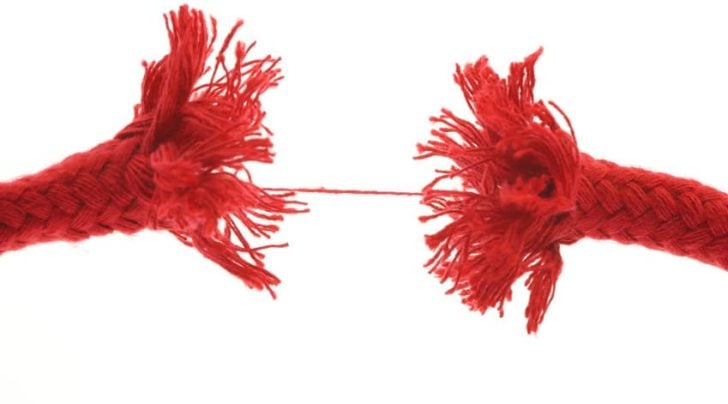
A distal bicep tendon tear or tear of your bicep tendon at the elbow are a common cause of pain, swelling and a “Popeye” bicep deformity. Many patients tell the same story. They were lifting something, usually with someone helping them. The other person stumbles or let go and your end dropped—
POP! You heard a horrible sound coming from your elbow. Over the next day or two swelling and bleeding will be seen around the elbow. If you look closely you will notice a deformity of your biceps muscle. The bicep tendon is the most commonly torn tendon around your elbow. If you suspect that your tore your biceps tendon you should see an Orthopedic Surgeon sooner rather than later. We prefer to fix these tendons — if you choose to have surgery — within the first 3 weeks after the injury.
The biceps not only assists you in bending your elbow, it helps you turn your forearm so you can turn a screwdriver, open a door, etc. The biceps serves many important functions.
Injuries to the biceps are fairly common. Most people who tear their biceps clearly recall the event. You were helping someone carry something heavy, the other person let go and you felt your biceps tendon pop. You went to lift up someting quickly and felt a pop. These are very common stories.
The diagnosis of a distal biceps tendon tear near the elbow is usually not hard to make. The question is:
Does A Bicep Tear Require Surgery?
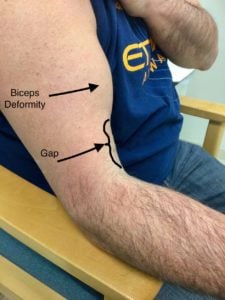
Surgery is not necessary for all bicep tendon tears. But surgery for biceps tendon tears is recommended for many active adults.
Can you consider treating a biceps tendon tear without surgery?
Many of you might lead a very sedentary life. You do not use your arms for anything more than normal activities of daily living. If you are willing to live with a biceps muscle deformity, then you will usually do very well without surgery for your biceps tendon tear. You shouldn’t notice any weakness, but might have an occassional spasm in the muscle.
If you, however, you live an active life, and certainly if you rely on your arms for work then you should consider having surgery to repair your biceps tendon tear. As mentioned previously, distal biceps tears should be repaired within a few weeks after the injury. Otherwise it might be very difficult to repair the tendon.
How is a Biceps Tendon Repaired?
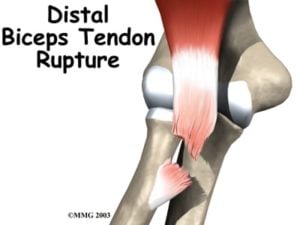
When the biceps tears, the tendon snaps up into the arm. We make a small incision across the front of the elbow, the torn biceps tendon is identified and brought back down to its normal attachment on a bone we call the radius. Then we must attach it to the radius. When we repair the bicep tendon tear we can use sutures, suture anchors or other devices which help secure the biceps back in place on the radius. After the biceps is repaired, the skin is closed and we place you into a splint.
After the surgery you are in a splint for a 7-10 days, then a sling. You will likely start moving the arm soon to prevent stiffness, but you will not be allowed to lift anything for a number of months. If you try to do too much you will re-tear the biceps tendon.
After we give the biceps tendon enough time to heal to the radius bone you start physical therapy. Once you have completed your therapy, most patients are capable of returning to full activities — including sports, jobs with heavy lifting, and weight lifting.
Risks of Biceps Tendon Surgery
There are risks to any surgery, and surgery for a biceps tendon tear is no different. Overall the risks are very low. The risks of a biceps tendon repair include infection, elbow stiffness, numbness in the forearm, and a potential injury to a nerve which can cause weakness in your wrist.


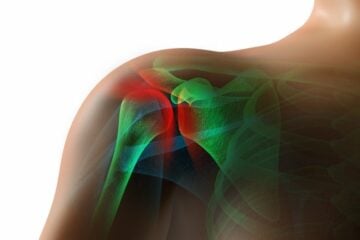

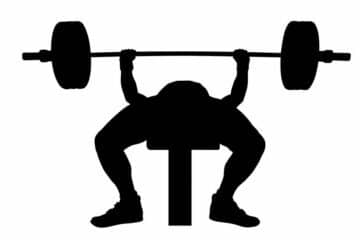





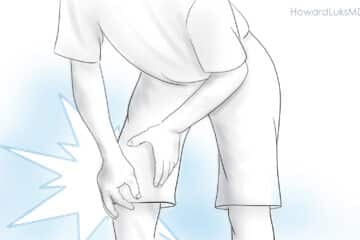



Hi Dr.
I’m 34 and have been body-building for 8 years
I suffered what I suspected a Proximal tear or rupture in my left arm about 8 weeks ago in the gym arm curling on the preacher bench (single arm 30kg) a weight I can comfortably do 3 sets of 8 when I heard a tearing sound (not a pop) as I lifted the weight, I instantly dropped the weight and went to the doctors the morning after where she was not very helpful and just said to rest it, she offered an X ray but followed it up with “it wont show anything being a muscle injury”
6 weeks past and it felt fine again so I made another doctors appointment and asked if I can resume weightlifting and just start off light and he gave me the all clear.
So started back in the gym on the weights and all was going well then at work (I’m a mechanic) I was pulling on something when I heard a loud click/crack in my shoulder and the pain returned but it subsided very quickly this time (3 days) but I’m now very un-easy about doing anything with my left arm and I think the deformity has worsened (poppy muscle) I can rotate my hand without issue and I seem to be able to lift without issue, weirdly the only time I now feel pain is when getting soap out the soap dispenser at work so with my palm facing up and using my palm to press the dispenser button the pain is on the inside of my arm near my arm pit also if I poke deep in at my armpit I can replicate the pain.
When I asked the doctor about surgery it was quickly dismissed but as my job is physical with heavy lifting and I’m an active body-builder (hobby not professional) could I push for surgery?
If not or in your opinion not worth it could I every return to weightlifting without issue that’s all I’m really interested in I could live with the deformity but I need to be able to trust it at work and in the gym, last thing I want is to be doing something like removing a gearbox on a lift so above my head when it goes and I drop it on me or someone else?
I would appreciate any advise at all.
Thanks Darren
Proximal biceps ruptures produce very little weakness with overhead lifting. If the deformity doesn’t bother you then most would say to live with it. In some patients, a proximal biceps rupture will produce spasm too… rare but possible. If the spasm persists then some will choose to have it fixed to minimize the discomfort.
That’s great to hear thanks,
Will I be able to train back to a similar strength in that arm?
Am I right in assuming the other remaining bicep head will pick up the slack for the broken one?
I don’t think I’ll ever curl on a preacher bench again as it seems to be a common cause of the rupture
Again thanks for your advise it’s put my mind at ease.
Thanks darren
Is 4 weeks too long to wait to have surgery
It’s getting really close to the end of our comfort zone.
My son was waterskiing in early August. Upon trying to get up on the skis he felt a pop and pain to his right armpit area. Numbness/unable to use arm for a few minutes, then RICE treatment for the weekend. Some bruising to triceps area the next few days. Now, 3 months later, some strength returning, but unable to do pull ups or hang from a bar. He’s a weight lifter. He also cannot flex his pectoralis muscle like he did before the accident. There is a indentation along his upper lat when he flexes. MD said possible torn tendon of lattissimus or teres major. Very little information about the repair of this. What do you know about this type of injury that happens to water skiers and pitchers. Is surgery the best option or is it better to treat it without surgery. My son is very concerned that he’ll never be able to do a pull up or resume his regular weight lifting activities. Do you know of any orthopedic surgeion who specializes in axillae surgery? We live in Southern Ohio. Thanks.
Tough case … And 3 months after the injury a repair will be very difficult. Many shoulder docs would be comfortable with this. Joe Ianotti, Brian Cole in Chicago, Ken Yamaguchi in St Louis … don’t know anyone offhand in OH … but the academic centers should have someone.
My dad tore his bicep tendon don’t know if its the long one or short one its been about 4 months and two weeks is it still possible to attached it to the top with surgery or is it too late
At four months it’s likely still possible … but why does he want to do it?
He’s worried about having complications later on down the road like his arm hurting feeling pain and doesn’t like how it looks his bicep is leaning to the inside of his arm
And He wants to know what’s the best way to go about this situation should he have surgery or not he’s afraid that if he lift heavy it will tear again or start hurting he does a lot of heavy lifting that’s why he’s concerned